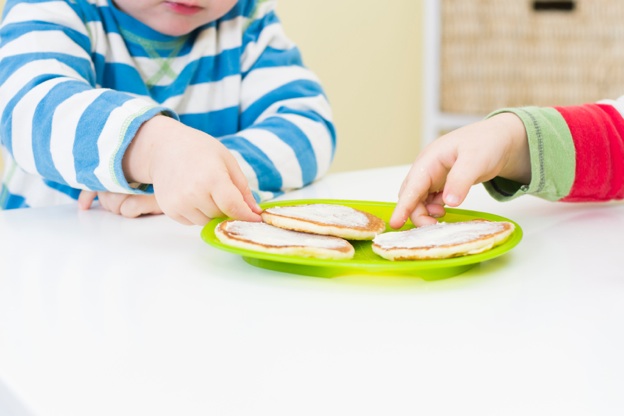SingaporeMotherhood | Baby & Toddler
January 2012
Get your child to eat: Develop positive mealtime habits with your baby or toddler

Psychologist Shona Lowes and Karen Wright, a dietitian at the Food Clinic, work together to help families deal with picky and fussy eating habits in children. Many mums stress out at mealtimes and wind up with kids who balk at the table for years on end. Shona shares what parents can do to fix fussy eating habits, especially with kids who have allergies that may cause additional anxieties around food. Her tips, however, apply to anyone who has a picky eater.
Exploring and experiencing food — help children learn to enjoy food
It is important for children to learn from a young age that food is interesting and enjoyable. You can help your child to learn this by making use of all the senses when it comes to food, whether it is a mealtime, preparing food, playing with pretend food or shopping for food in the supermarket. This can start in a very simple way with babies less than a year old and be extended as they enter the toddler years.
Allow your child to…
Spend time exploring their food. Don’t rush mealtimes in the early stages, and remember it is a whole new thing for your child and they want to learn all about it.
Make a mess. View any mess as an exploration, as the child gets older you can begin to introduce more of the social rules of eating. Most children move from the messy stage naturally as they go from exploring to eating and enjoying the food.
Feed themselves if they want to. Allow your child that independence, it is all part of learning new skills.
Try new tastes. Even if your child does not appear to enjoy a food initially, continue to offer it on different occasions, without pressure to eat but focusing on the senses around that particular food, until the child shows the interest themselves to try to eat it.
Use all of the senses
Sight – talk to your child about the appearance of food – colours, shapes, textures, draw their attention to the food, help them to look at it by holding it up at eye level.
Smell – hold food to your nose and smell in an exaggerated way making enthusiastic comments about the smell of the food, let your child smell the food, begin to use different words to describe the smell.
Touch – encourage your child to touch the food, let them feel if it is wet or dry, rough or smooth. Doing this from the very first stages of weaning onto solid foods is an excellent way to help your child explore the food – in a way that they would do naturally. Don’t worry about the mess! Seat your child in an area that is easily cleaned, take off their best clothes (she can even eat just in a nappy at this stage), find a ‘cover all’ bib.
Taste – you can demonstrate the tasting of food and responding in a positive and enthusiastic way. When your child puts food in her mouth, comment on the taste of the food for her – “mmmmm tastes good”. As children get a bit older, see if they can identify different tastes.
Make mealtimes
Sociable – always sit with your child at mealtimes. Even if it is not your mealtime, sit with a coffee and chat with your child while they eat. Talk about the food and other things that are happening in their life. This forms a good basis for sociable mealtimes as your child grows older; children often remember mealtimes in a positive way and enjoy the quality family time.
Routine – around mealtimes gives positive cues for hunger and for learning appropriate mealtime behaviour.
Relaxed – food is always much more enjoyable if everyone is relaxed. If you find that you are beginning to feel stressed at mealtimes, find ways to manage this and try to identify the source of the stressed feelings.
Enjoyable – spending time together and enjoying the food.
Reasons for loss of appetite or refusal of eat
It is important to realise that there are many reasons why a child may refuse to eat at one meal or one day. If you can identify a possible reason then this also helps you deal with it in a more relaxed way. Reasons may include an illness, teething, tiredness, change of routine, new food, parental reaction, distractions and natural variations in their appetite.
What if my child refuses food?
- Think about possible reasons to explain this.
- Remain calm and relaxed.
- Your child may make it up at the next meal.
- Look at 24-hour schedule — particularly how much milk the child is drinking.
- Continue to present new food to child at each meal without pressure to eat it.
The value of Praise
You can use praise and positive encouragement to help your child learn to enjoy food and to learn to be adventurous with new foods. You can praise:
- Trying new foods
- Sitting at the table or in high chair for a reasonable amount of time
- Self-feeding
- Being cooperative
- Eating larger quantities
Ignore
- Refusal to eat
- Demands for different foods or presentations
- Distractions
How to praise
- Always label praise so that your child knows what they did well
- Get eye contact with your child before praising
- Smile with your mouth and your eyes!
- Use an enthusiastic tone of voice
- Accompany verbal praise with a hug, a high five etc
- Always use verbal praise to accompany tangible rewards (for older children)
Cris Sivashanmugam is the editor of sneezywheezy.com, Singapore’s only allergy blog.
All content from this article, including images, cannot be reproduced without credits or written permission from SingaporeMotherhood.
Follow us on Facebook, Instagram, and Telegram for the latest article and promotion updates.






